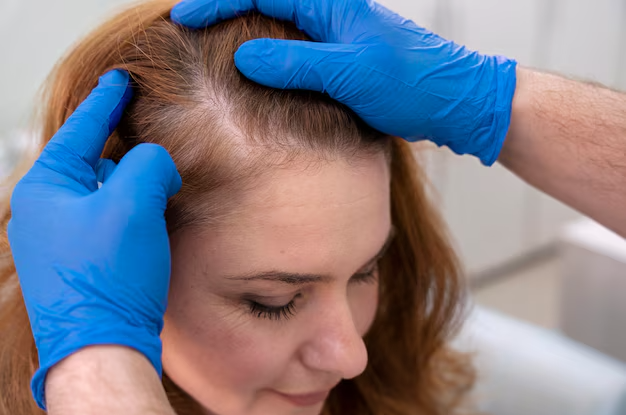Hair loss is often seen as an inevitable part of ageing for both men and women, but women, in particular, often find themselves facing a unique set of challenges and misconceptions when it comes to hair thinning.

From feeling like it’s something they should simply accept to grappling with a lack of information, the myths surrounding women’s hair loss can be overwhelming.
The truth is, women’s hair loss is far more common—and treatable—than many people realise. Today, let’s bust some of these myths wide open and empower you with the real facts.
Myth 1: Hair Loss Is Only a Male Problem
One of the most pervasive myths about hair loss is that it’s something only men have to deal with. While male-pattern baldness is more well-known, women face their own unique forms of hair loss.
In fact, statistics show that about 40% of women experience hair thinning by the time they reach 50. However, the way hair loss manifests in women is often more subtle, making it less noticeable at first.
Unlike men, who often experience bald patches or receding hairlines, women typically experience diffuse thinning, especially around the crown or temples. This can make it harder to recognise early on. But don’t be fooled—women’s hair loss is real, and it is treatable.
Myth 2: Women’s Hair Loss Is Caused Only by Stress
It’s true that stress can be a contributing factor to hair loss, but it’s far from the only reason.
Many women believe stress is the sole cause of their thinning hair, but the reality is that several other factors—such as genetics, hormonal imbalances, and underlying medical conditions—are often at play.
Hormonal fluctuations, especially during pregnancy, menopause, or conditions like polycystic ovary syndrome (PCOS), are some of the most common culprits behind women’s hair loss. And, of course, genetics also play a large role.
If your mother or grandmother had thinning hair, there’s a higher chance you might face the same issue. Stress can exacerbate these problems, but it’s rarely the primary cause.
Myth 3: There’s Nothing You Can Do About Women’s Hair Loss
This myth is perhaps the most harmful. Many women simply resign themselves to the fact that hair loss is inevitable, often due to the misconception that there are no effective treatments.
The truth is that hair loss can be managed, and in many cases, it can even be reversed with the right approach.
One of the most important steps in managing hair loss is early intervention. Dr. Edward Maitland Ball, a leading hair restoration expert, emphasises that proper diagnosis is essential for effective treatment. “Addressing early signs like temple thinning or hair breakage is key,” he says. This is why I always recommend seeking help as soon as you notice the first signs of hair thinning.
From FDA-approved treatments like minoxidil to cutting-edge therapies like platelet-rich plasma (PRP) treatments, there are many options available to help you restore your hair. Some women also find success with hair restoration surgeries, such as follicular unit extraction (FUE) or follicular unit transplantation (FUT), which can provide long-lasting results.
If you’d like to learn more about how to identify and address the early signs of hair loss, take a look at the Maitland Clinic guide, which offers detailed information on treatment options and how to recognise symptoms early.
Myth 4: Women’s Hair Loss Is Caused by Poor Diet or Not Taking Care of Their Hair
While a poor diet can certainly contribute to hair loss, it is rarely the primary cause.
Hair thinning can be influenced by many other factors, including hormonal changes, genetics, and even certain medications. However, that doesn’t mean a healthy diet isn’t important for maintaining strong, healthy hair.
Nutrient deficiencies—especially in iron, zinc, and biotin—can contribute to hair shedding. However, focusing solely on diet can often distract from more pressing causes of hair loss.
A balanced diet is essential for overall health, but it won’t be the magic cure for underlying conditions like genetic hair loss or hormonal imbalances. It’s also important to remember that while we can’t control genetics or hormones, we can take steps to minimise damage to our hair. Using gentle hair care products, avoiding excessive heat styling, and steering clear of harsh chemical treatments can all help preserve the health of your hair.
Myth 5: Hair Loss Means You’ll Go Bald
This myth tends to frighten many women, but it’s simply not true. While some women experience severe thinning, complete baldness is very rare.
Most women will experience gradual thinning, which is much more manageable. With early intervention and the right treatment, many women are able to restore their hair to a fuller, thicker state.
In fact, many women who undergo hair restoration treatments see remarkable results. The key is to act early.
Whether it’s through non-surgical methods like PRP therapy or surgical options like hair transplants, there are plenty of options to help you regain your confidence and a fuller head of hair.
Myth 6: Hair Loss Is Just Part of Aging—You Have to Accept It
Ageing is a natural part of life, and it can affect the thickness and quality of your hair.
However, that doesn’t mean you have to accept hair loss as a part of getting older.
While it’s true that hair thinning can occur with age, there are many ways to manage it and even reverse the effects.
Whether you choose medical treatments, lifestyle changes, or even a hair transplant, there is always something you can do to improve your hair health.
Key Takeaway
Don’t accept hair loss as inevitable. Empower yourself with accurate knowledge and early intervention to restore your hair and confidence. Explore your treatment options today!
